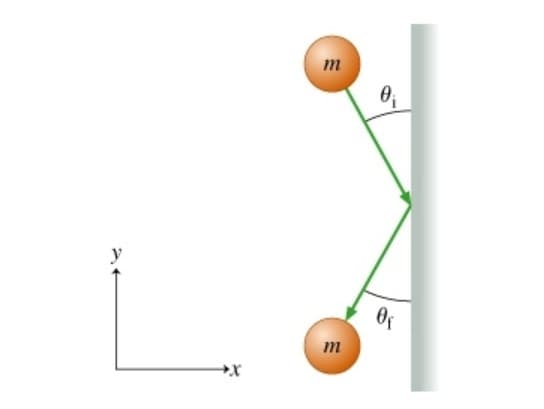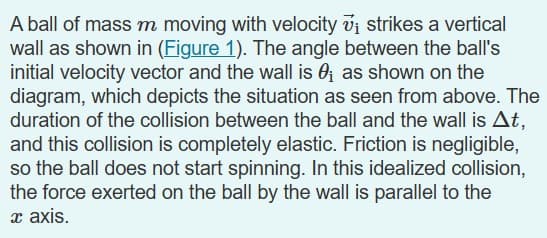Classical Dynamics of Particles and Systems
5th Edition
ISBN:9780534408961
Author:Stephen T. Thornton, Jerry B. Marion
Publisher:Stephen T. Thornton, Jerry B. Marion
Chapter11: Dynamics Of Rigid Bodies
Section: Chapter Questions
Problem 11.31P
Related questions
Question
What is the final angle θf that the ball's velocity vector makes with the negative y axis?

Transcribed Image Text:y
X+
m
m
0

Transcribed Image Text:A ball of mass m moving with velocity 7₁ strikes a vertical
wall as shown in (Figure 1). The angle between the ball's
initial velocity vector and the wall is 0₁ as shown on the
diagram, which depicts the situation as seen from above. The
duration of the collision between the ball and the wall is At,
and this collision is completely elastic. Friction is negligible,
so the ball does not start spinning. In this idealized collision,
the force exerted on the ball by the wall is parallel to the
x axis.
Expert Solution
This question has been solved!
Explore an expertly crafted, step-by-step solution for a thorough understanding of key concepts.
This is a popular solution!
Trending now
This is a popular solution!
Step by step
Solved in 2 steps

Knowledge Booster
Learn more about
Need a deep-dive on the concept behind this application? Look no further. Learn more about this topic, physics and related others by exploring similar questions and additional content below.Recommended textbooks for you

Classical Dynamics of Particles and Systems
Physics
ISBN:
9780534408961
Author:
Stephen T. Thornton, Jerry B. Marion
Publisher:
Cengage Learning

Classical Dynamics of Particles and Systems
Physics
ISBN:
9780534408961
Author:
Stephen T. Thornton, Jerry B. Marion
Publisher:
Cengage Learning